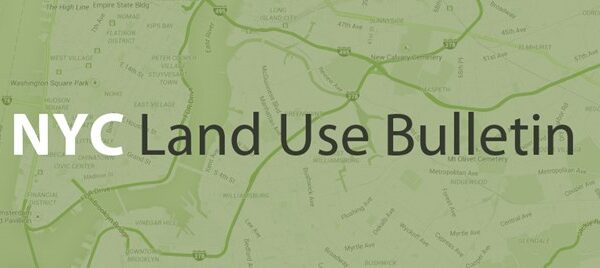
NYC Land Use Bulletin: Agreement on 421-a Provides New Opportunities for Development
The Governor and Legislature have reached an agreement on a revamped 421-a program, renamed The Affordable New York Housing Program, which had lapsed on January 15, 2016.
The agreement restores a tax abatement program for residential development in New York City that has not been available since January 2016. Real property tax relief provides an important incentive to spur the development of rental housing — both market rate and affordable. In addition, where Mandatory Inclusionary Housing (MIH) is applicable, the 421a incentives can help to realize the goals of MIH by reducing overall development costs.
The agreement keeps many of the elements of the previous program with key changes related to rental buildings of 300 or more units located within “Enhanced Affordability Areas”, which cover Manhattan south of 96th Street and areas of Brooklyn and Queens, generally within one mile of the East River Waterfront.
In order to be eligible for the property tax exemptions, these projects would be required to provide 25 or 30 percent of units as affordable, and pay minimum average construction wages (including salary and benefits) of $60 per hour in the Manhattan Area, and $45 per hour in the Brooklyn and Queens Enhanced Affordability Areas.
Projects would receive a full 35-year property tax exemption benefit and an extended 40-year affordable housing preservation period would be required. Projects of 300 or more units outside these areas could opt into the enhanced benefit program provided all requirements are met.
The Affordable New York Housing Program would be applicable to eligible projects that had commenced construction beginning in December 31, 2015 and extending to June 15, 2022. The program would continue to exclude all condominium/cooperative developments in Manhattan, as well as those in the other boroughs with more than 35 units.
Other Rental Buildings
The new legislation would continue to require that all other rental buildings receiving benefits would be subject to requirements that 25 or 30 percent of the units in the development would have to be affordable, depending on income levels. The benefit period for these rental buildings would include a full exemption for 25 years, and a partial exemption for 10 years based on the amount of affordable units included in the developments.
For reference, Area Median Income (AMI) for a family of four is $84,300.
The affordability options included are below.
Affordability Options
Affordability Option A – 25% affordable requirement
- 10% of units at no more than 40% AMI.
- 10% of units at no more than 60% AMI.
- 5% of units at no more than 130% of AMI.
Projects would be eligible to receive tax exempt bonds and 4% tax credits.
Affordability Option B – 30% affordable requirement
- 10% of units at no more than 70% AMI.
- 20% of units at no more than 130% AMI.
Affordability Option C – 30% affordable requirement; not available in Manhattan South of 96th Street
- 30% of units must be affordable at 130% AMI.
These projects would not be eligible for substantial government assistance.
Affordability Option D (Condominium and Co-op Homeownership)
A real estate tax exemption for 14 years followed by a partial exemption for the subsequent six years would be available for home ownership projects for buildings outside of Manhattan that do not contain more than 35 units. 100 percent of the units must have an average assessed value not to exceed $65,000 upon the first assessment following the completion date. In addition, the unit owner must agree to maintain the unit as their primary residence for no less than five years.
Enhanced Affordability Areas –300+ Unit Buildings
Additional requirements are imposed for rental buildings with at least 300 dwelling units within Enhanced Affordability Areas. These include Manhattan south of 96th Street, and Community Districts 1 and 2 in Brooklyn and Queens, generally within a mile of the East River waterfront.
Eligible buildings in these areas would receive a full 35-year tax exemption and would have to comply with average hourly wage requirements (including benefits) for construction of $60 in the Manhattan Area, and $45 in the Brooklyn and Queens Enhanced areas. These buildings would also be required to maintain affordability requirements for 40 years. Projects of 300 or more units outside these areas could opt into this enhanced exemption period provided they fulfill all of the requirements.
The affordability options for these areas generally track affordability options A, B, and C, with some modest variations:
Affordability Option E – 25% affordable requirement
- 10% of units at no more than 40% AMI.
- 10% of units at no more than 60% AMI.
- 5% of units at no more than 120% of AMI.
Projects would be eligible to receive tax exempt bonds and 4% tax credits.
Affordability Option F – 30% affordable requirement
- 10% of units at no more than 70% AMI.
- 20% of units at no more than 130% AMI.
Affordability Option G – 30% affordable requirement; not available in Manhattan South of 96th Street
- 30% of units must be affordable at 130% AMI.
These projects would not be eligible for substantial government assistance.
Other Requirements
As in prior legislation, a number of requirements would continue to apply:
- Buildings with more than 30 units would be required to pay prevailing wages for building service workers.
Certain other rules apply relating to rent stabilization and affordability.
- Common access to affordable and market units will be required.
Buildings receiving 421-a benefits would have to share the same common entrances and common areas as the market rate units, and affordable units cannot be isolated to a specific floor or area of the building.
Where can I get more information?
We encourage you to contact our experienced team to discuss how we can assist you in understanding and utilizing these new important benefits for your project or development.
CLAIRE ALTMAN
Executive Vice President for Affordable Housing + Community Development
212-616-5839
Claire@nullcapalino.com
RICHARD BARTH
Executive Vice President of Housing + Real Estate Strategies
212-616-5845
Richard@nullcapalino.com
CHRISTOPHER COLLINS
Executive Vice President of Land Use + Real Estate Strategies
Christopher@nullcapalino.com
212-616-5848
Get The Latest From Capalino! Sign up for our free weekly newsletter for a roundup of top news and appointments from New York City and State government straight to your inbox every Friday. Click here to subscribe to Affairs+Appointments.




